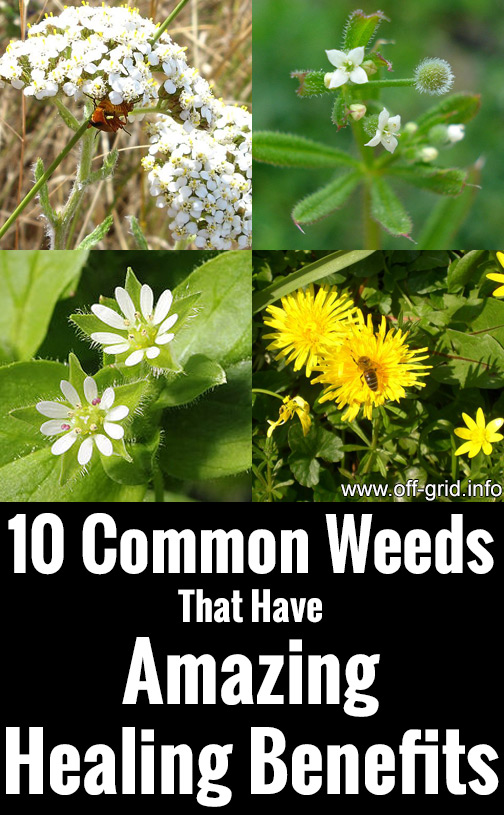Click Here To Join Our Telegram Channel for FREE daily tutorials!

10 Common Weeds That Have Amazing Healing Benefits. Photos – Wikipedia: 1 2 3 4 – lic. under CC 3.0
Introduction

Modern healthcare professionals are increasingly accepting of the benefits of herbs in treating common ailments. New drugs are appearing all the time but there is very little knowledge of the long term effects of these – a lot of them contain chemicals that weren’t even in existence a decade ago! Unwelcome side effects are common but are considered a risk worth taking in the pursuit of curing the symptoms of illness.
Many of the medicines made by drug companies have their origins in natural plant derivatives so why not go straight to the source? Some herbalists claim that the use of plant material as medicine works in a more balanced way than the isolated active ingredients.
Every day we are bombarded with advertisements of the newest pill for pain, fever and many more – resultant of the billions of dollars spent on the health care system. But did you know how much money we would actually save by going back to our roots — literally? A quick look at your backyard will actually reveal important herbs that have potent healing abilities, the same herbs used hundreds of years ago in the absence of these pharmaceutical conglomerates. Here are 10 “weeds” that aren’t weeds at all but plants with amazing health benefits…
#1 – Shepherd’s Purse (Capsella burse-pastoris)
Shepherd’s Purse is aptly named because of the shape of its pods, which resemble a heart-shaped purse. Part of the Brassica family (a.k.a. the mustard family), this plant is rich in Vitamin C and K, sodium, and sulfur and has been used historically to stem bleeding, specifically during World War I. A study published in 2014 revealed that Shepherd’s Purse has potent anti-inflammatory and antibacterial characteristics, able to inhibit the growth of bacteria that is resistant to a strong antibiotic, Vancomycin. Other studies have even found Sheperd’s purse’s sulforaphane content to have chemopreventative effects as well, being able to inhibit the growth of tumors. [1][2]
#2 – Cleavers (Galium aparine)

Cleavers are climbing plants with sharp, spiky leaves, typically regarded as a pest or weed wherever they grow. Extracts from this plant revealed highly potent antioxidant properties, able to reduce oxidative stress and damage caused by free radicals in the body. Free radicals come from toxins and foreign substances and circulate in the blood stream, damaging blood vessels and tissues. A variation of this plant under the scientific name Galium verum has been found to have cancer-fighting abilities, inhibiting tumor growth and promoting cancer cell death. This can be linked to the cleavers’ ability to improve immunity and antibody synthesis. [3][4][5][6]
#3 – Chickweed (Stellaria media)
Chickweed is an herb that has been used for hundreds of year in traditional Chinese medicine for skin-related ailments like dermatitis. Rich in flavonoids and other immune-boosting substances, this plant is able to inhibit inflammation and viral activity. Because of these characteristics, chickweed shows great promise in managing one of the deadliest diseases – Hepatitis B. Researchers in 2012 discovered that the inherent mix of flavonoids, polysaccharides, and proteins in chickweed had great potential in fighting Hepatitis B. [7]
#4 – Dandelion
Dandelions are beautiful flowers to some but pesky weeds to others. However, this fact cannot be denied – it’s rich in vitamins A, B, C, and D, iron, potassium, and zinc – vitamins and minerals that contribute to a healthy body. The roots, stems, leaves, and flowers have been used over time to manage a variety of conditions – from liver and kidney disease to stomach aches and heartburn. Recent studies have backed up these claims, finding dandelion roots as a rich source of antimicrobial compounds and extracts from both the leaves and roots able to control the deposition of fat in the body (adipogenesis), decreasing the risk for obesity, cardiovascular, and endocrine diseases. [8][9]
#5 – Groundsel (Senecio vulgaris)

Groundsel has gained the reputation of being a toxic herb, and to an extent there is some truth to this claim. Ingesting groundsel will not cause any immediate, life-threatening symptoms but they can harm cattle and similar animals’ liver when the plant’s leaves are ingested in small amounts over a long period of time. However, in the history of humans, groundsel has been used as an herbal remedy for its anti-bleeding and diuretic properties. Some forms of the plant can even alleviate mild stomach problems and aches. Recent studies have even found antibacterial and antifungal characteristics from groundsel extracts. A variation of groundsel (Senecio graveolens) has also shown promise in treating breast cancer, being able to target breast cancer cells specifically. [10][11][12][13]
#6 – Mallow (Malva family)
Used primarily in traditional Mediterranean and European medicine, the Malva family of herbs colloquially called Mallows has potent anti-inflammatory and antioxidant properties. The leaves of the plant showed the best antioxidant capabilities, able to rid the body of free radicals and unwanted peroxidation of stored lipids. In a study in 2012 on Marva parviflora, the plant was able to inhibit insulin resistance and lipid elevation – two things associated with diabetes, an endocrine disorder that affects millions of people all over the world. A more recent study in 2015 revealed that the ability of Malva sylvestris in the management of functional constipation. [14][15][16]
#7 – St. John’s Wort (Hypericum perforatum)
St. John’s Wort is an herb popular for its ability to manage depression and other neurological disorders. Hypericin and hyperforin are the two main substances found in the herb that contribute to its potent therapeutic characteristics. A study published in 2013 concluded that St. John’s wort is an effective alternative to generic antidepressants, with the added bonus of being cheaper and therefore more cost-effective in the treatment of depression. Another study revealed St. John Wort’s ability to prevent Alzheimer’s disease by protecting the brain from the build-up of beta-amyloids, amino-acids that contribute to the development of Alzheimer’s. Other researchers have even started looking at other therapeutic effects of the herb, finding that St. John’s Wort could also prevent weight gain and insulin resistance. [17][18][19][20]
#8 – Self Heal (Prunella vulgaris)
The herb “self heal” is a popular one in traditional Asian medicine, primarily for the management of inflammation, eye problems, and headaches. Particularly, the variant lilacina has been shown to have potent anti-allergic, anti-inflammatory, anti-oxidative, anti-microbial, and anti-viral properties. A study in 2013 revealed the ability of lilacina’s extract to fight cancer. Other recent studies have strengthened the claims of Self Heal’s antioxidant and immune-boosting properties, able to fight tumor proliferation in cases of lung cancer. [21][22][23]
#9 – Usnea (Usnea Barbata)
The usnea plant is a fungus part of the lichen family, extensively studied because of their strong antioxidant capabilities. Commonly called “old man’s beard” because of its white, hairy appearance, it has been found quite beneficial in the management of cancer and oxidative stress. The component usnic acid was found to be responsible in the effectiveness of the herb to kill cancer cells and remove free radicals, all without causing mutation or damage to body’s normal and healthy cells. [24][25]
#10 – Yarrow (Achellia Millefolium)
According to legend, yarrow earned its scientific name from the fictional Greek hero Achilles using the herb to stop bleeding among his soldiers. In European folk medicine, the plant is used to manage stomach problems and improve digestion, as well as relieving dyspepsia and menstrual cramps. This can be attributed to the anti-spasmodic effects of the plant, able to relax the smooth muscles in the body, particularly in the stomach. [26][27][28]
Safety Note: Although many herbs are considered safe, certain herbs (as with allopathic medicines) are not suitable for use during pregnancy and there can be risks involved when taking them in combination with other medications or when suffering from certain health conditions. Always check with your doctor before using herbs if pregnant, using any medications or have health conditions. Equally important – if you are collecting these plants yourself, please be absolutely sure that they have not already been sprayed with weedkiller. Also don’t forget the old saying that “prevention is better than cure” so a varied, balanced diet and regular physical exercise will go a long way to keeping you in good health!
References:
[1] Penn State College of Agricultural Sciences. Shepherd’s Purse. http://extension.psu.edu/pests/weeds/weed-id/shepherds-purse
[2] Choi, W., et. al. (2014). Anti-Inflammatory and Anti-Superbacterial Properties of Sulforaphane from Shepherd’s Purse. http://www.ncbi.nlm.nih.gov/pmc/articles/PMC3951821/
[3] Bauer, G., et. al. (2011). Always on the bright side: the climbing mechanism of Galium aparine. http://www.ncbi.nlm.nih.gov/pmc/articles/PMC3107623/
[4] Bokhari, J., et. al. (2013). Evaluation of diverse antioxidant activities of Galium aparine. http://www.ncbi.nlm.nih.gov/pubmed/23211618
[5] Zhao, R., et. al. (2011). Protective effects of diosmetin extracted from Galium verum L. on the thymus of U14-bearing mice. http://www.ncbi.nlm.nih.gov/pubmed/21851214
[6] Amirghofran, Z., et. al. (2011). The effect of the methanol extract of Galium mite on the cellular immunity and antibody synthesis. http://www.ncbi.nlm.nih.gov/pubmed/21574089
[7] Lihua, M., et. al. (2012). Anti-Hepatitis B Virus Activity of Chickweed
[Stellaria media (L.) Vill.] Extracts in HepG2.2.15 Cells. file:///C:/Users/dell/Downloads/molecules-17-08633.pdf
[8] University of Maryland Medical Center. Dandelion. http://umm.edu/health/medical/altmed/herb/dandelion
[9] Gonzales-Castejon, M., et. al. (2014). Reduction of adipogenesis and lipid accumulation by Taraxacum officinale (Dandelion) extracts in 3T3L1 adipocytes: an in vitro study. http://www.ncbi.nlm.nih.gov/pubmed/23956107
[10] Weed Science Society of America. Common Groundsel. http://wssa.net/wp-content/themes/WSSA/WorldOfWeeds/groundsel.html
[11] Loizzo, M., et. al. (2004). Antibacterial and antifungal activity of Senecio inaequidens DC. and Senecio vulgaris L. http://www.ncbi.nlm.nih.gov/pubmed/15478193
[12] Sahu, S., Khushwaha, A. & Dixit, R. (2011). Computational identification of miRNAs in medicinal plant Senecio vulgaris (Groundsel). http://www.ncbi.nlm.nih.gov/pmc/articles/PMC3280435/
[13] Echiburu-Chau, C., et. al. (2014). The selective cytotoxicity elicited by phytochemical extract from Senecio graveolens (Asteraceae) on breast cancer cells is enhanced by hypoxia. http://www.ncbi.nlm.nih.gov/pubmed/24535330
[14] Barros, L., et. al. (2010). Leaves, flowers, immature fruits and leafy flowered stems of Malva sylvestris: A comparative study of the nutraceutical potential and composition. http://www.sciencedirect.com/science/article/pii/S0278691510001614
[15] Perez-Gutierrez, R. (2012). Evaluation of hypoglycemic activity of the leaves of Malva parviflora in streptozotocin-induced diabetic rats. http://www.ncbi.nlm.nih.gov/pubmed/22290526
[16] Elsagh, M., et. al. (2015). Efficacy of the Malva sylvestris L. flowers aqueous extract for functional constipation: A placebo-controlled trial. http://www.ncbi.nlm.nih.gov/pubmed/25801702
[17] Lawvere, S. & Mahoney, M. (2005). St. John’s Wort. https://www.researchgate.net/profile/Martin_Mahoney2/publication/7426926_St._John’s_wort/links/540d8acc0cf2f2b29a386673.pdf
[18] Solomon, D., Adams, J. & Graves, N. (2013). Economic evaluation of St. John’s wort (Hypericum perforatum) for the treatment of mild to moderate depression. http://www.ncbi.nlm.nih.gov/pubmed/23291009
[19] Brenn, A., et. al. (2014). St. John’s Wort reduces beta-amyloid accumulation in a double transgenic Alzheimer’s disease mouse model-role of P-glycoprotein. http://www.ncbi.nlm.nih.gov/pubmed/23701205
[20] You, M., et. al. (2014). Effect of St. John’s Wort (Hypericum perforatum) on obesity, lipid metabolism and uterine epithelial proliferation in ovariectomized rats. http://www.ncbi.nlm.nih.gov/pmc/articles/PMC4058563/
[21] Hwang, Y., et. al. (2013). In vitro antioxidant and anticancer effects of solvent fractions from prunella vulgaris var. lilacina. http://www.ncbi.nlm.nih.gov/pmc/articles/PMC4226201/
[22] Li, C., et. al. (2015). Characterization, antioxidant and immunomodulatory activities of polysaccharides from Prunella vulgaris Linn. http://www.ncbi.nlm.nih.gov/pubmed/25596012
[23] Wang, P., et. al. (2014). [Effects of extracts of Prunella Vulgaris L. on proteome of human lung adenocarcinoma cell line A549]. http://www.ncbi.nlm.nih.gov/pubmed/25331476
[24] Zugic, A., et. al. (2016). Evaluation of Anticancer and Antioxidant Activity of a Commercially Available CO2 Supercritical Extract of Old Man’s Beard (Usnea barbata). http://www.ncbi.nlm.nih.gov/pmc/articles/PMC4706385/
[25] Turkez, H., Aydin, E. & Aslan, A. (2012). Effects of Lichenic Extracts (Hypogymnia physodes, Ramalina polymorpha and Usnea florida) on Human Blood Cells: Cytogenetic and Biochemical Study. http://www.ncbi.nlm.nih.gov/pmc/articles/PMC3813136/
[26] University of Maryland Medical Center. Yarrow. http://umm.edu/health/medical/altmed/herb/yarrow
[27] Moradi, M., et. al. (2013). Antispasmodic effects of yarrow (Achillea millefolium L.) extract in the isolated ileum of rat. http://www.ncbi.nlm.nih.gov/pubmed/24311877
[28] Borrelli, F., et. al. (2012). Prokinetic effect of a standardized yarrow (Achillea millefolium) extract and its constituent choline: studies in the mouse and human stomach. http://www.ncbi.nlm.nih.gov/pubmed/22151891

This Crazy Off Grid Device Literally Makes Drinkable Water From Fresh Air:
According to NASA, the U.S. is expecting a 100-YEAR LONG MEGADROUGHT.
It's already begun. Ask the farmers in California. They know.
Every survivalist knows that water is of critical importance. You NEED an independent water source that you can count on!
As an interesting "survival rehearsal" - imagine that you turned the tap on right now and nothing came out. How long would you last?
But what if there was another water source literally hidden in plain sight. That's right, I'm talking about the atmosphere!
The amazing thing about getting water from the natural moisture in the air... is that it is ALWAYS available.
This gives you real water security!
Learn more about how to tap into "Nature's secret water reservoir" and stay hydrated when TSHTF!
Watch the video:
� What Tinnitus Does To Your Brain Cells (And How To Stop It)
After 47 years of studies and countless brain scans done on more than 2,400 tinnitus patients, scientists at the MIT Institute found that in a shocking 96% of cases, tinnitus was actually shrinking their brain cells.
As it turns out, tinnitus and brain health are strongly linked.
Even more interesting: The reason why top army officials are not deaf after decades of hearing machine guns, bombs going off and helicopter noises...
Is because they are using something called "the wire method", a simple protocol inspired by a classified surgery on deaf people from the 1950s...
Most People Don't Have The Guts To Try This:
An amazing discovery in an abandoned house in Austin, Texas: A lost book of amazing survival knowledge, believed to have been long vanished to history, has been found in a dusty drawer in the house which belonged to a guy named Claude Davis.
Remember... back in those days, there was no electricity... no refrigerators... no law enforcement... and certainly no grocery store or supermarkets... Some of these exceptional skills are hundreds of years of old and they were learned the hard way by the early pioneers.
>> Click here to find out about them now
We've lost to history so much survival knowledge that we've become clueless compared to what our great grandfathers did or built on a daily basis to sustain their families.
Neighbors said that for the last couple of years Claude has tried to unearth and learn the forgotten ways of our great-grandparents and claimed to have found a secret of gargantuan proportions. A secret that he is about to reveal together with 3 old teachings that will change everything you think you know about preparedness:
>> Click Here To Watch The Video <<
What REALLY Happens When You Bury a Shipping Container? (Hint: It's A Bit Crazy...)
Shipping containers are all the rage - but if you are thinking about buying one, you MUST watch this video first:
Do not, I repeat do NOT do what these lunatics did! Can you spot the "fatal mistake" they made?
There's a general belief that if you bury a shipping container you can create an awesome root cellar / storm shelter / survival bunker.
But is a shipping container strong enough to handle the pressure?
Watch the video to see what happens:
What Really Happens When You Bury a Shipping Container? (Click To Watch Video)

I Can't Help Showing This Off:
If you haven't heard of Claude Davis yet do yourself a huge favor and watch this video.
One of the smartest guys I ever had the pleasure of meeting, Claude set-up a unique prepping system that changed his life forever.
I already tried it myself and let me tell... you I was completely blown away... His surprising tactics could make your life easier and give you the peace of mind you deserve.
Don't just take my word for it... watch his short video and decide for yourself.
>> Click Here To Watch The Video <<

More Off-Grid And Survival Resources:













This article would be much more useful if photos of the weeds accompanied each description